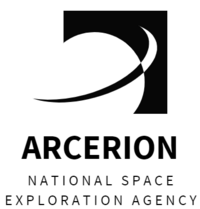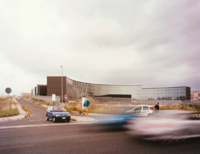Arcer National Space Exploration Agency (ANSEA)
 Emblem of the ANSEA | |
 Presdale, Arcerion | |
| Agency overview | |
|---|---|
| Formed | 1977 |
| Preceding agency |
|
| Type | Space Exploration, Space Warfare |
| Jurisdiction | Domestic, Foreign |
| Headquarters | ANSEA Building Presdale, Moorden Governorate, Arcerion |
| Motto | "To stars beyond." |
| Employees | 22,550 (2021 estimate) |
| Annual budget | £53 billion (as of 2019[update]) |
| Agency executives |
|
| Parent agency | Arcerion Ministry of Defence |
| Website | Template:Url |
Generic Overview The Arcer National Space Exploration Agency (ANSEA) is a government agency established in 1977 to fund, regulate, and coordinate the space exploration activities of the Cronan nation of Arcerion. The agency cooperates with a number of different international organizations across Ixnay as well as private sector space companies who are active in both aerospace, aeronautical, and space research and technology. The Arcer National Space Exploration Agency is the leading interstellar organization in Crona for Launch Vehicles, utilizing the wide-open swathes of the Arcer Heartland to provide an ideal area for the Northlea Spaceport, the largest interstellar launch, command, and control facility of its type in Crona.
In Arcerion, ANSEA is responsible for publishing a memorandum to the Confederate Parliament on an annual basis and upon its approval, to ensure it is enacted within the confines of the budget and provisions set out by the federal government. ANSEA also has a Budgetary office which works closely with the Treasury Office and Ministry of Finance to regulating bidding on spaceflight projects and capital procurements for spaceflight in Arcerion.
ANSEA's main headquarters is in the Northern Arco city of Presdale, with two smaller stations, the National Arcerion Space Observatory (NASO) in Foxhey Governorate, and the Chester Space Centre in Southern Arcerion, which assists with launch vehicle recovery and some unmanned/manned spaceflight testing. The ANSEA also maintains relay stations in Stenza (STENZ PLS APPROVE BY DELETING THIS), and the Burgundie-held Equitoreal Ostiecia for radio rebroadcast and satellite communications links.
History
Early Arcer Aerospace
Chester Programme
Merging of Military and Civilian Efforts
Programmes
Unmanned Exploration
Arcerion maintains a sizeable robotic exploration program, the first large scientific satellite mission for Crona was the Lion I-series of launch vehicles, carrying the first Arcer satellite, Intrepid. It was launched as Arcerion's first unilateral space mission, and was the inaugural launch for the Northlea Spaceport, occurring in 1981. While it was considered unilateral as it was funded and primarily constructed within Arcerion, some Occidental experts were quietly hired by the federal government of Arcerion to provide their expertise. The objective, which was successfully completed, was to conduct weather studies of the storm patterns in the Malentine, Songun, and Polynesian Seas to assist the Royal Arcerion Naval Service planning for future expeditionary operations. The Intrepid is the longest-serving satellite in Ixnay, still beaconing weather recordings as of 2026. In 1989 the first Arcer unmanned vehicle was landed on the Moon as part of the Lion IIa-series launcher program, with Rover 6 sucessfully taking samples and delivering them to an unmanned pod, which returned the samples to Arcerion for study. One of the moon rocks is on display in the Confederate Parliament.

Since 1990, Arcerion has also provided the Lion IIa and Lion III series boosters and launch vehicles (rockets) to lift commercial satellites into orbit. In 2001, Arcerion launched a constellation of military satellites under the ARTEMIS-programme, which aimed to provide increased satellite imagery and spaceborne intelligence collection for the Armed Forces of Arcerion. This constellation would remain in place until 2019, when the first ARTEMIS II-series satellite was launched in cooperation with CRONASAT.
Launch Vehicle Programme (LVP)
Arcerion's Launch Vehicle Program, or LVP comprises one of Ixnay's most advanced rocket propellant and rocket engineering technology centres. It began with the Lion-series rockets (later renamed to Lion I), and over several decadeds matured as changing requirements for satellite lift, manned spaceflight, and orbital delivery influenced the path and overall trajectory of the programme.
The current series of rockets undergoing development, the Lion IVb, are the first reusable rockets designed by Arcerion to be able to serve multiple launches as a cost-efficiency initiative as well as part of growing calls for the environmental impacts of space travel. Arcerion currently is expected to field a fleet of roughly fifteen Lion IVb rockets and their associated booster and supporting equipment, to agument the current fleet of several dozen older Lion IIIb and Lion IIIg series rockets.